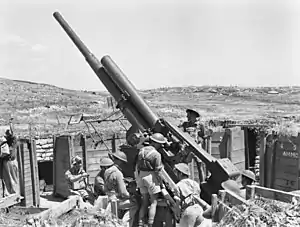Western Australian emergency of March 1942
The Western Australian emergency of March 1942 was a series of local responses that occurred in relation to activity in northern Western Australia that gave Australian military forces serious concerns about the capacity of the Japanese to move down the Western Australian coast.
| Western Australian emergency of March 1942 | |
|---|---|
| Part of the Pacific War | |
 One of the anti-aircraft guns assigned to the defence of Fremantle during a training exercise in November 1943 | |
| Objective | Reinforcement of Western Australia in response to a feared Japanese attack |
| Date | March 1942 |
The air raids on Broome and other locations in March 1942 caused the Allies to reinforce the military forces located in Western Australia to defend the state.[1][2][3][4]
The action was taken to defend against the possibility that a force of Japanese warships and planes would attempt to attack the cities of Fremantle and Perth.[5]
The speed and extent of Japanese expansion to this time was considered a major threat to the region.[6][7][8]
Extensive preparations and actions throughout the state of Western Australia were conducted to avert attacks and to prepare the population against possible invasion.[9][10]
Japanese propaganda was produced at the time to spread the idea of invasion or bombing of southern Australian cities.[11] Authorities were attempting to allay fears a month before the Darwin bombings.[12]
The events surrounding the bombings and response by authorities in northern Australia were referred to as "Japanese Scare" tactics.[13][14]
The work undertaken in Fremantle and Perth to prepare for an imminent invasion or attack was the most extensive in the history of Western Australia.
The establishment of the Fremantle submarine base was a part of the defensive actions, and it remained active until the end of the war.
The subsequent Western Australian emergency of March 1944 was in effect a repeat of the 1942 emergency.
References
- "Australia bombed, strafed and shelled". Australia Under Attack 1942–1943. Australian War Memorial. Archived from the original on 15 July 2005. Retrieved 17 February 2016.
- Verheijke, Emma; Netherlands Ambassade (Australia); Western Australian Museum (2012), Broome: 3 March 1942 – 3 March 2012, Embassy of the Kingdom of the Netherlands; Welshpool, W.A.: Western Australian Museum, retrieved 24 September 2016
- Prime, Mervyn W; Broome Historical Society (2007), Broome's One Day War: The Story of the Japanese Raid on Broome 3rd March 1942 (Updated ed.), Broome Historical Society, retrieved 24 September 2016
- "The Japanese bombing of Darwin, Broome and northern Australia". australia.gov.au. Retrieved 25 September 2016.
- "Invasion 1942? Australia and the Japanese Threat" (PDF). Parliament of the Commonwealth of Australia. 29 April 1992. p. 8. Retrieved 26 September 2016.
- "Map of the Japanese advance". Australia's War 1939–1945. Department of Veterans' Affairs. Retrieved 25 September 2016.
- "Japanese Advance". Australia's War 1939–1945. Department of Veterans' Affairs. Retrieved 25 September 2016.
- http://pandora.nla.gov.au/pan/48398/20050315-0000/www.awm.gov.au/events/conference/2002/stanley_paper.pdf Remembering 1942 history conference - "He’s (not) Coming South": the invasion that wasn’t by Peter Stanley
- "Northern Times". Northern Times. 38 (9). Western Australia. 7 March 1942. p. 2. Retrieved 5 October 2018 – via National Library of Australia.
- "The Northern Times". Northern Times. 38 (13). Western Australia. 2 April 1942. p. 2. Retrieved 5 October 2018 – via National Library of Australia.
- ""Beware Fake Messages" Scare Talk of Raids on Cities". The Sydney Morning Herald (32, 520). 20 March 1942. p. 7. Retrieved 25 September 2016 – via National Library of Australia.
- "Scare Rumours Are the Product of Fifth Columnists". The Worker. 52 (2849). Brisbane. 10 February 1942. p. 1. Retrieved 25 September 2016 – via National Library of Australia.
- "Are Japanese Raids on Darwin to scare us?". The Telegraph. Brisbane. 13 April 1942. p. 4 (Second Edition). Retrieved 25 September 2016 – via National Library of Australia.
- The term is not specifically referred to in the titles of papers presented, but the years events are over-viewed. See "2002 History Conference – Remembering 1942". Australian War Memorial. Archived from the original on 15 March 2005. Retrieved 25 September 2016.
Further reading
- Smith, Graham McKenzie (2009). Defending Fremantle, Albany and Bunbury: 1939–1945. Mount Pleasant, Western Australia: Grimwade Publications. ISBN 9780980629101.